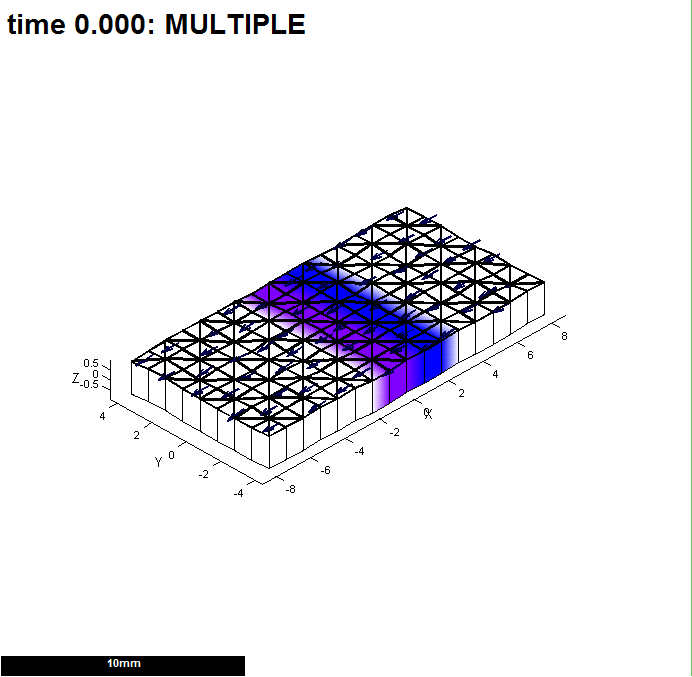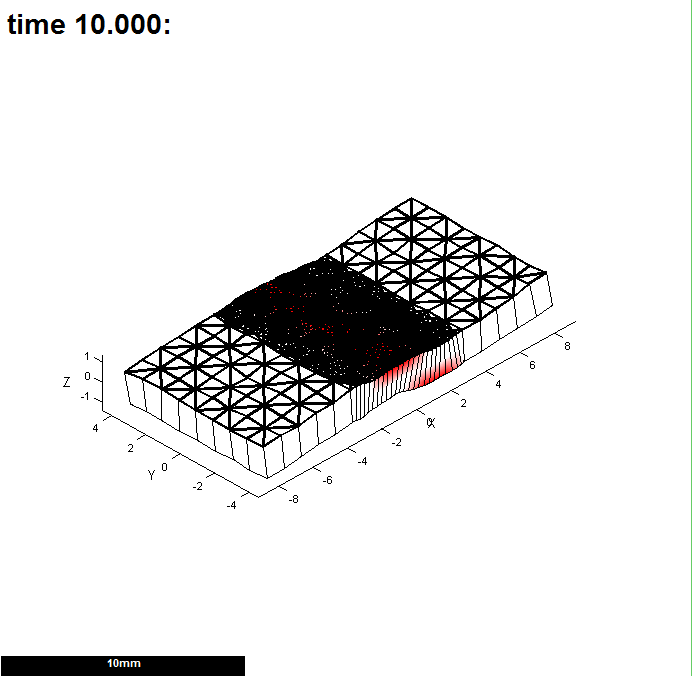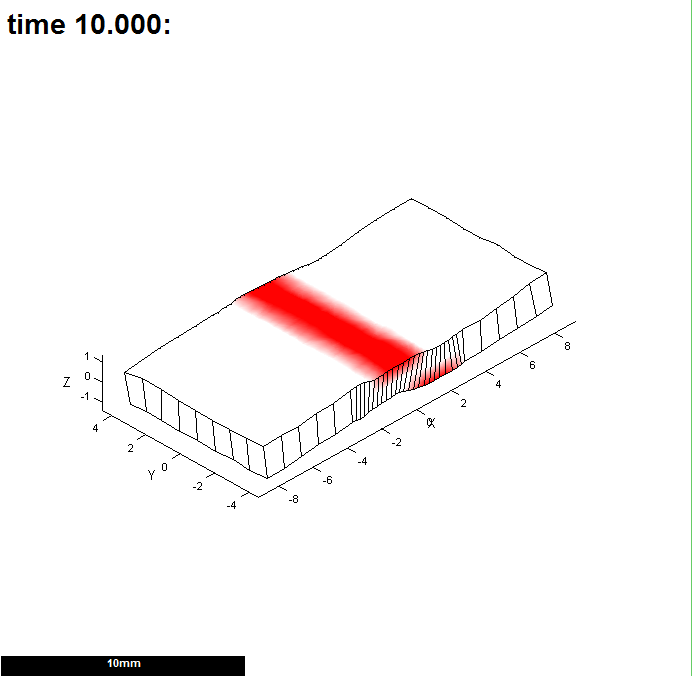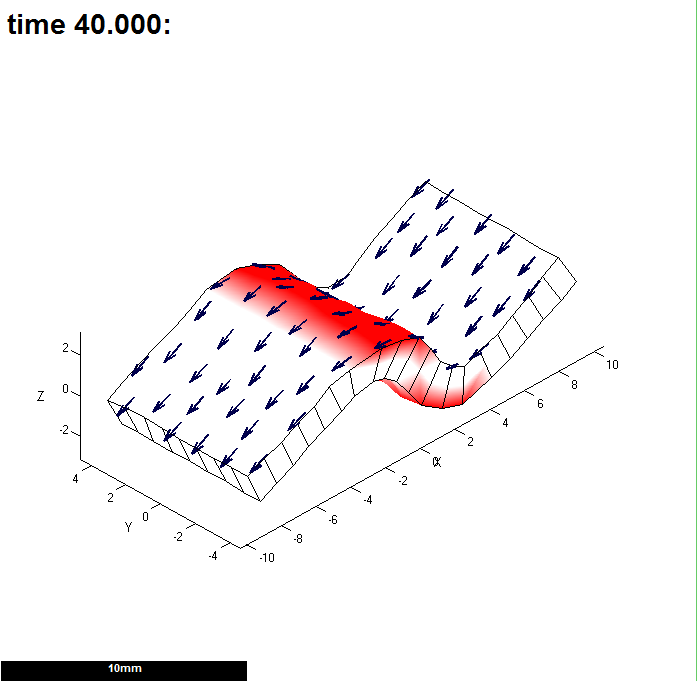Mesh: tradeoff
Return to GFtbox hints and tips
Subdividing the mesh to ensure sufficient resolution to compute curves properly
There is a tradeoff between speed and the accuracy with which curves are computed in meshes. Curves are approximated by a series of straight lines. With too few points, curves will be discontinuous and computed inaccurately. With too many points the computation will be slow. It is, therefore, desirable to vary the density of vertices in the initial mesh according to the expected curvature (you have to run models many times to get this right). This is an example of subdividing a rectangular mesh in the region in which curves will develop.
It still might not be correct because the stepsize might be too big, See time tradeoffs
It still might not be correct because the tolerances might be too large, See tolerance tradeoffs
Tutorial
Run the project (example project )for 40 steps to see the effect of:
- subdivision
Then change the modelname to 'NOSUBDIVISION', i.e. make a change to the interaction function
% Set up names for variant models. Useful for running multiple models on a cluster.
m.userdata.ranges.modelname.range = { 'NOSUBDIVISION', 'WITHSUBDIVISION' }; % CLUSTER
m.userdata.ranges.modelname.index = 2; % CLUSTER
by setting index to 1. With too few elements, bends are jagged.
The interaction function is shown below, red highlights the region of interest.
function m = gpt_demosubdivision_20121116( m ) %m = gpt_demosubdivision_20121116( m ) % Morphogen interaction function. % Written at 2012-11-16 12:30:06. % GFtbox revision 4351, . % The user may edit any part of this function between delimiters % of the form "USER CODE..." and "END OF USER CODE...". The % delimiters themselves must not be moved, edited, deleted, or added. if isempty(m), return; end fprintf( 1, '%s found in %s\n', mfilename(), which(mfilename()) ); try m = local_setproperties( m ); catch end realtime = m.globalDynamicProps.currenttime; %%% USER CODE: INITIALISATION % In this section you may modify the mesh in any way whatsoever. if (Steps(m)==0) && m.globalDynamicProps.doinit % First iteration % Zero out a lot of stuff to create a blank slate. % If no morphogens are set in the GUI it may be useful to % zero some arrays by uncommenting the following. % m.morphogens(:) = 0; % m.morphogenclamp(:) = 0; % m.mgen_production(:) = 0; % m.mgen_absorption(:) = 0; % m.seams(:) = false; % m.mgen_dilution(:) = false; % Set up names for variant models. Useful for running multiple models on a cluster. m.userdata.ranges.modelname.range = { 'NOSUBDIVISION', 'WITHSUBDIVISION' }; % CLUSTER m.userdata.ranges.modelname.index = 1; % CLUSTER end modelname = m.userdata.ranges.modelname.range{m.userdata.ranges.modelname.index}; % CLUSTER disp(sprintf('\nRunning %s model %s\n',mfilename, modelname)); % to plot polariser on the A side and resultant areal growth rate on the B side: m = leaf_plotoptions( m, 'morphogenA', 'KAPAR', 'morphogenB', 'KBPAR' ); %%% END OF USER CODE: INITIALISATION %%% SECTION 1: ACCESSING MORPHOGENS AND TIME. %%% AUTOMATICALLY GENERATED CODE: DO NOT EDIT. if isempty(m), return; end setGlobals(); global gNEW_KA_PAR gNEW_KA_PER gNEW_KB_PAR gNEW_KB_PER global gNEW_K_NOR gNEW_POLARISER gNEW_STRAINRET gNEW_ARREST dt = m.globalProps.timestep; polariser_i = gNEW_POLARISER; P = m.morphogens(:,polariser_i); [kapar_i,kapar_p,kapar_a,kapar_l] = getMgenLevels( m, 'KAPAR' ); [kaper_i,kaper_p,kaper_a,kaper_l] = getMgenLevels( m, 'KAPER' ); [kbpar_i,kbpar_p,kbpar_a,kbpar_l] = getMgenLevels( m, 'KBPAR' ); [kbper_i,kbper_p,kbper_a,kbper_l] = getMgenLevels( m, 'KBPER' ); [knor_i,knor_p,knor_a,knor_l] = getMgenLevels( m, 'KNOR' ); [strainret_i,strainret_p,strainret_a,strainret_l] = getMgenLevels( m, 'STRAINRET' ); [arrest_i,arrest_p,arrest_a,arrest_l] = getMgenLevels( m, 'ARREST' ); [id_a_i,id_a_p,id_a_a,id_a_l] = getMgenLevels( m, 'ID_A' ); [id_b_i,id_b_p,id_b_a,id_b_l] = getMgenLevels( m, 'ID_B' ); [id_subdivide_i,id_subdivide_p,id_subdivide_a,id_subdivide_l] = getMgenLevels( m, 'ID_SUBDIVIDE' ); % Mesh type: rectangle % base: 0 % centre: 0 % randomness: 0.1 % version: 1 % xdivs: 16 % xwidth: 16 % ydivs: 8 % ywidth: 8 % Morphogen Diffusion Decay Dilution Mutant % -------------------------------------------------- % KAPAR ---- ---- ---- ---- % KAPER ---- ---- ---- ---- % KBPAR ---- ---- ---- ---- % KBPER ---- ---- ---- ---- % KNOR ---- ---- ---- ---- % POLARISER ---- ---- ---- ---- % STRAINRET ---- ---- ---- ---- % ARREST ---- ---- ---- ---- % ID_A ---- ---- ---- ---- % ID_B ---- ---- ---- ---- % ID_SUBDIVIDE ---- ---- ---- ---- %%% USER CODE: MORPHOGEN INTERACTIONS % In this section you may modify the mesh in any way that does not % alter the set of nodes. if (Steps(m)==0) && m.globalDynamicProps.doinit % Initialisation code. % Put any code here that should only be performed at the start of % the simulation, for example, to set up initial morphogen values. id_a_p((m.nodes(:,1)>0)&(m.nodes(:,1)<=2))=1; id_b_p((m.nodes(:,1)>-2)&(m.nodes(:,1)<=0))=1; id_subdivide_p((m.nodes(:,1)>=-2)&(m.nodes(:,1)<=2))=1; P=m.nodes(:,1); end if realtime<=1 kapar_p(:) = 0; kaper_p(:) = 0; kbpar_p(:) = 0; kbper_p(:) = 0; knor_p(:) = 0; else kapar_p(:) = 0.05*id_a_p; kaper_p(:) = 0; kbpar_p(:) = 0.05*id_b_p; kbper_p(:) = 0; knor_p(:) = 0; end %%% END OF USER CODE: MORPHOGEN INTERACTIONS %%% SECTION 3: INSTALLING MODIFIED VALUES BACK INTO MESH STRUCTURE %%% AUTOMATICALLY GENERATED CODE: DO NOT EDIT. m.morphogens(:,polariser_i) = P; m.morphogens(:,kapar_i) = kapar_p; m.morphogens(:,kaper_i) = kaper_p; m.morphogens(:,kbpar_i) = kbpar_p; m.morphogens(:,kbper_i) = kbper_p; m.morphogens(:,knor_i) = knor_p; m.morphogens(:,strainret_i) = strainret_p; m.morphogens(:,arrest_i) = arrest_p; m.morphogens(:,id_a_i) = id_a_p; m.morphogens(:,id_b_i) = id_b_p; m.morphogens(:,id_subdivide_i) = id_subdivide_p; %%% USER CODE: FINALISATION % In this section you may modify the mesh in any way whatsoever. switch modelname case 'NOSUBDIVISION' % do nothing case 'WITHSUBDIVISION' % subdivide on the first step if realtime>0 && realtime<=0+dt m = leaf_subdivide( m, 'morphogen','id_subdivide',... 'min',0.5,'max',1,... 'mode','mid','levels','all'); end if realtime>0 && realtime<=0+dt m = leaf_subdivide( m, 'morphogen','id_subdivide',... 'min',0.5,'max',1,... 'mode','mid','levels','all'); end otherwise % If this happens, maybe you forgot a model. end %%% END OF USER CODE: FINALISATION end




